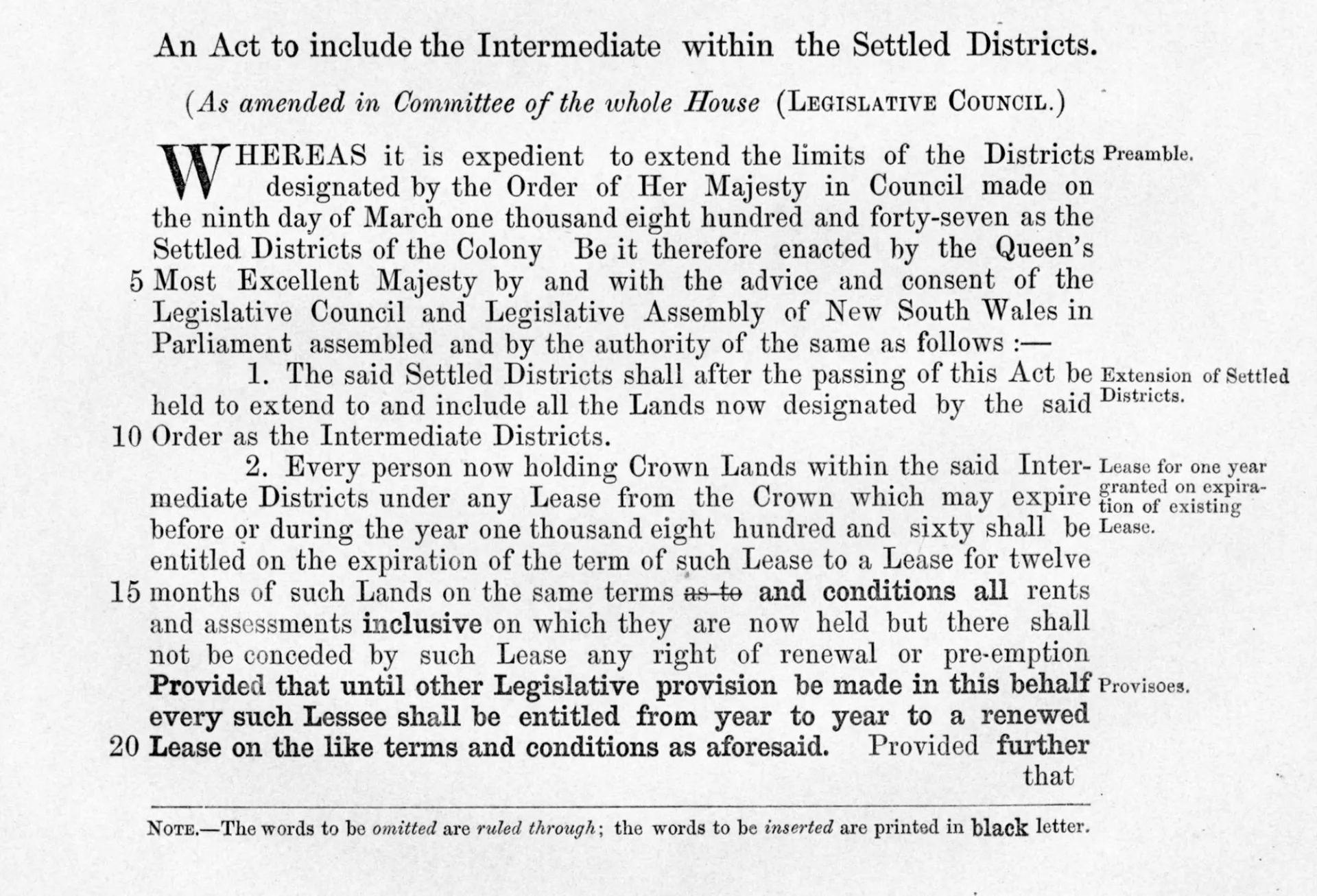Violent Shapes on Stolen Land
Dennis Grauel, 30 September 2024

Crown Lands Temporary Regulation Bill 1859.
First published in a pamphlet for The Spoil Grounds, a boat charter and symposium on Awabakal and Worimi waters and lands: Port of Newcastle and South Pacific Ocean, Saturday 7 September 2024. Organised by Therese Keogh.
I live on Sovereign, unceded Wurundjeri Woi Wurrung Land as an uninvited guest. What does it mean to make fonts in this place?
Typography in so-called australia carries a banal violence. It is an epistemological violence: an overwhelming incursion of colonial systems of knowledge which erase, displace and extract. These systems of knowledge are consistently marked by the smooth legibility of letter shapes in colonial documents:
• Land deeds – formalising dispossession of Aboriginal land
• Maps – delineating parcels of stolen land for a private property market and extractive industry
• Bank notes – enabling the frictionless trade of that land as capital between settler-occupiers
• Institutional insignia – authorising a monopoly on violence for agents of the state and capital
It seems that however state institutions enact power, a bureaucratic arsenal of documents is deployed – a kind of performance in which a cast of Latin typefaces naturally and dutifully inscribe the state’s claims to a standard of incontestable legibility.
In Seeing like a State, James C. Scott writes about legibility as a requisite to state intervention:
Any substantial state intervention in society—to vaccinate a population, produce goods, mobilize labor, tax people and their property, conduct literacy campaigns, conscript soldiers, enforce sanitation standards, catch criminals, start universal schooling—requires the invention of units that are visible.
This sense of legibility (of bodies, natural resources, land) is broader than the clarity of letterforms on a page, but the need for typographic legibility pervades attempts to establish any novel unit of legibility.
Writing in The Design Politics of the Passport, Mahmoud Keshavarz importantly implicates the agency of documents as more than post factum evidence of state violence:
… passports or visas are not simply products or signifiers of the borders but rather the very components that constitute border politics. They are the very material and performative practices that produce borders.
This notion of documents performing is also noted in Law’s Documents, where Katherine Biber, Trish Luker and Priya Vaughan write:
Documents — in manifold and multiple forms — perform, proliferate and perpetuate the law.
As such, the land deed is not a consequence of dispossession; it is an active participant. The map, rather than representing space, reproduces the surveyor’s logic of property.
The violence of these documents is typically characterised by an unexciting aesthetic. Chris Lee describes this function of design in his book Immutable:
when it comes to the document, graphic design is also charged with halting time: fixing the form and meaning of signs, and stabilizing governmentality by locating claims in commonly apprehensible forms, squarely in the realm of the banal and thus more safely outside of contestation.
However, Lee notes that:
… we find that no document ever achieves the absolute immutability (depoliticization) it seeks; every document is met with attempts to subvert, challenge, or invalidate it.
Tending instead to a legacy of forgery, counterfeiting, parody and sabotage, how might we engage antagonistically with documents and typography in this place? What might an illegible typographic practice look like? What can we learn through reappropriating these shapes or turning them against their masters?
References
1 — James C. Scott, Seeing Like a State: How Certain Schemes to Improve the Human Condition Have Failed (New Haven and London: Yale University Press, 1998) 183.
2 — Mahmoud Keshavarz, The Design Politics of the Passport: Materiality, Immobility, and Dissent (London: Bloomsbury, 2019) 8.
3 — Katerine Biber, Trish Luker & Priya Vaughan ed., Law’s Documents: Authority, Materiality, Aesthetics (New York: Routledge, 2022) 21.
4 — Chris Lee, Immutable: Designing History (Eindhoven: Onomatopee/Library Stack, 2022) 4.
5 — Chris Lee, Immutable: Designing History (Eindhoven: Onomatopee/Library Stack, 2022) 2.